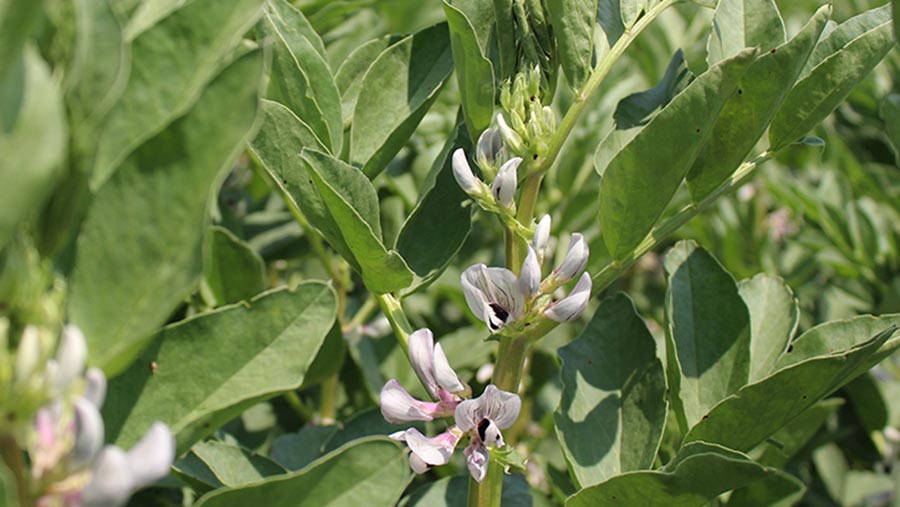Suffolk grower drops sugar beet and ups winter bean area
 Winter beans in flower in Suffolk
Winter beans in flower in Suffolk With sugar beet prices in the mire and soil fertility a growing concern, a Suffolk grower has made the difficult decision to ditch the crop and give winter beans a bigger part to play in his rotation.
Michael Craske farms just outside the market town of Hadleigh, about 10 miles west of Ipswich, in partnership with his brother and mother.
The family farm 625ha of arable land plus a further 95ha of grassland on a combination of Hanslope and Beccles series loamy clays.
See also: Herbicide-tolerant crops have growing role in weed control
Last year saw 35ha of sugar beet harvested with Mr Craske becoming increasingly worried about damage being inflicted on his soils.
Beet lifting tends to drag on into the winter with deteriorating conditions potentially playing havoc with soil structure.
“It’s a later crop that’s in the ground a long time and can be tricky when harvesting in a wet November. The beet harvest drags on, the land gets wet and damage is done.
“I’m sad about not growing sugar beet anymore because we do get good yields, but with reduction in prices we have got to start looking at other options,” he says.
Despite a general swing to spring cropping this season to help growers tackle weeds and in some cases reduce costs, Mr Craske has chosen a different path.
Last autumn he made the change from spring to winter beans because he views it as a less risky crop.

Suffolk grower Michael Craske ©Oli Hill/RBI
The farm last grew winter beans eight years ago but now Mr Craske says he accepts the need to look at other break crops, as growing oilseed rape is becoming increasingly difficult without neonicotinoid seed treatments to combat the high flea beetle numbers in the area.
“We have moved over to winter beans from the spring beans because I think if conditions are right in the autumn, why not get them in? Why risk it and wait until spring when it could be wet?” he adds.
This season the farm is growing 43ha of the winter bean variety Tundra. The crop was sown on 26 October at a seed rate of 230kg/ha.
Mr Craske opted to spin them on with an Amazone spreader, plough them in and then use a follow up cultivation with a Simba Toptilth to level the land up.
This technique saw remarkably quick germination and crop emergence, with Mr Craske reporting plants bursting through the ground only a few weeks after they were sown. This was likely helped by good soil moisture and a mild winter.
Soil health and weed control
“Sugar beet causes damage to the soil because it is in the ground a long time. With winter beans the soil is very friable, it helps with the soil structure and you get a good crop of wheat afterwards because of the nitrogen fixing,” explains Mr Craske.
Winter bean regime
- Seed rate: 230kg/ha
- Drilled: late-October
- Fungicides: Alto Elite (chlorothalonil and cyproconazole), and a three-way mix of Amistar (azoxystrobin), Bravo (chlorothalonil) and tebuconazole
- Herbicides: Stomp (pendimethalin) and Crawler (carbetamide)
Providing he is happy the performance of the winter beans this harvest, he will increase the area next season with the hope that the crop will nurture his soils while also helping to control weeds.
Blackgrass is present on the farm and growing winter beans adds further herbicide options to the weed control toolbox.
“It means we can use different herbicide actives to help control weeds better. We have blackgrass here so it is helpful to use different herbicides.”
With sustained low grain prices forcing growers to look for ways to cut costs, Mr Craske says another advantage of growing winter beans is that input costs are lower than for other crops.
“Relatively it is a cheaper crop to grow compared with wheat or barley and fungicides aren’t that expensive either.
“Winter beans might not be the biggest earner of all the crops on the farm, but I think they make sense if you look at the rotation as a whole.”
He notes that buying the seed was the biggest expense this year, but he will likely home-save seed this harvest to cut that cost for next season.
With the crop now setting its pods, and having not grown winter beans for nearly a decade, Mr Craske says he is looking forward to finding out what they yield.
“So far I am very happy with the winter beans, they are looking good. I’m hoping for 5t/ha but time will tell,” he says.

